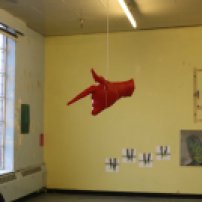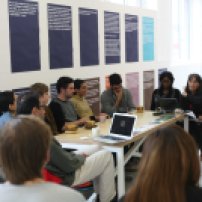Fresh Milk was very excited to travel to Glasgow this July to participate in the International Artist Initiated (IAI) project, presented by the David Dale Gallery & Studios as part of The Glasgow 2014 Cultural Programme which took place alongside this year’s Commonwealth Games. See below for more information and images from the project.
All photos taken by Rayanne Bushell.
About IAI:
International Artist Initiated is a programme of exhibitions and events devised by David Dale Gallery to coincide with the Glasgow 2014 Commonwealth Games. Developed over the past year, the project acted as a catalyst for discussion and collaboration between artist initiated projects internationally. The structure of the project was designed to be malleable and open source, in that it can be taken and applied elsewhere with different organisations.
Working with artist initiated, or focussed, organisations from across the six Commonwealth territories, the programme consisted of a series of exhibitions and events by the invited organisations that responded to either the context of the Commonwealth Games within Glasgow, or was representative of contemporary culture within their nation through the lens of an artist-led organisation.
The contributors to the programme were:
Fresh Milk, Barbados
Fillip, Canada
Cyprus Dossier, Cyprus
Clark House Initiative, India
RM, New Zealand
Video Art Network Lagos, Nigeria
Take a look at some picture from the opening night of IAI here:
Fresh Milk’s contribution to IAI was in two parts. The first saw the installation of works by three emerging artists on billboards, on railings and on the surface of the sidewalk. The artists include a recent graduate from the Barbados Community College, Ronald Williams, whose crisp digital montages critique the stereotype of the black athlete and were installed on an extended billboard, while Mark King’s temporal, geometric, site specific work was installed on a pavement. Alberta Whittle’s fête (party) posters show the artist masquerading as both man and woman in her critique of gender stereotypes through her engagement with the local fête posters often seen posted throughout Bridgetown, Barbados’ capital city. The posters were reproduced and displayed throughout the streets of Glasgow.
Ronald Williams’ Artist Statements:
My collages investigate the role that sports and the black athlete play in society. I manipulate popular based imagery to compose computer-generated images that explore sports, perceptions, stereotypes and fantasies about the black athlete or figure, conceptually becoming deliberately self-contradictory as the stereotype is simultaneously celebrated and criticized. The work is designed as a large-scale poster to be installed on a billboard as an adhesive decal similar to how the image of the modern sportsman is represented. The titles of the three images being exhibited are Swagga, The Phenomenon and Wild Thing.
Swagga
Sprinter Usain Bolt provides the inspiration for Swagga, a piece meant to capture the frivolous and boastful nature of celebration. The boa, hat, glasses and shoes combine to promote this ‘showy’ spectacle but are also linked to the Jamaican bling culture. While the animal skins on the legs hint at the relationship to fashion, it also indicates an inherent animalistic/ physically superior nature. The shirt, deliberately muted and understated, bears a statement from Marcus Garvey about knowledge of oneself and identity. As the African mask is obscured by the bright glasses and hat, the true significance of important sporting events—such as those of the Olympic Games which were of supreme importance in ancient Greece to a sporting hero as well as his city—is often lost amongst the glamorous festivity which accompanies it.
The Phenomenon
Jessie Owens’ performances at the 1936 Berlin Olympic Games were the catalyst for this piece. Owens defied Hitler’s claims about Aryan supremacy and the attitudes towards blacks in his own country by winning four gold medals. In America, the infirm and mortality rates of black children were high due to their lack of proper health care and social structure, but the common notion was that the blacks were just diseased and weaker in general. With Owens’ victory the narrative soon changed, and the now widely accepted stereotype of blacks being more athletically and physically gifted emerged. The idea of blacks being super or sub-human alternated between those two points and Owens was subjected to various tests to find what the secret was. To reflect this change, the head of the character and its arms indicate a non human entity with the study of eugenics paramount to the discussion. To highlight the use of the ‘sub-human’ black body for scientific and medical use, the Tuskegee experiments are included. Attached to the leg of the sprinter is the anti-slavery coin ‘Am I Not A Man And A Brother’ which serves as an anchor ball and chain. It symbolises the apparently never ending struggle for the black person to bee seen as equal, not super nor sub-human.
Wild Thing
Serena Williams’ bold fashion choices and trailblazing attitude helped inspire Wild Thing. Her 2002 attire, dubbed ‘the catsuit’, was such a huge talking point that it overshadowed the tennis being played. Comments about her ample curves, bulging muscles and inhuman speed and agility placed her in a highly sexualized yet animalsitic category. The character wears an exaggerated version of a catsuit, referencing the stereotypical association between African women and felines, while images of the Hottentot Venus place the fascination with her body to the fore. The black power racket and raised middle finger is a testament to her uncompromising and at times aggressive attitude, which is occasionally adverse to the demure nature of the sport.
_____________________________________________________________________________
Mark King’s Artist Statement:
My contribution to the Glasgow 2014 Culture Programme is a site-specific work made possible by the access provided by technology. Through virtual and interactive maps I embarked upon an exercise in way-finding from a computer thousands of miles away in Barbados. Through mechanisms such as Google Maps I selected forms present in the architecture and manipulated them to create artworks that draw upon the location where my work will be presented.
I have chosen chalk as my medium due to its ephemeral qualities. The resulting artwork is temporary much like the Commonwealth Games in Glasgow. My hope is that spectators from across the globe will come into direct contact with the piece with chalk from the artwork sticking to their shoes and hitching a ride to the neighboring sports venues. The combination of the elements and foot traffic will slowly eat away at the pigment and ultimately return the site to a state prior to my temporary intervention.
It is unknown whether the work will last for an hour, a day or the duration of the Commonwealth Games.
_____________________________________________________________________________
Alberta Whittle’s Artist Statement
I am interested in the conflict between historical images of the Other and the African Diaspora’s notions of the Self. The spectacle of racial differences relies on a language of bleak oppositions to confirm stereotypes. In Black Skin / White Masks, Frantz Fanon, observed that in colonial discourse “native” peoples are not positioned within the psychoanalytic structure of the Self and Other, but are relegated to the universe of objects, where they remain beyond the limits of cultural intelligibility.Focusing on the concept of subjective portraiture, both as art historical genre and public identity, my research has prompted me to interrogate the potential of Barbadian fete posters as a means of regaining subjectivity.
Whilst undertaking a residency at Fresh Milk in 2012, I began a series of digital collages, exploring the production and distribution of fete posters in Barbados. Fete posters are a platform for social commentary, highlighting the acute disparity between gender roles in Barbados, where these representations appear frozen. The posters advertising these “fetes” set the tone and introduce the hosts / hostesses. Each poster must present a selection of portraits of the hosts / hostesses, who enact a series of set poses, often sexually provocative or stereotypically hypermasculine. There are exceptions to this trope, where we are presented with more family-oriented fetes or fetes, which present a more Afro-centric or Rastafarian ideology. However, despite attempts to present themselves as rigidly heterosexual, there are elements of homoeroticism, identified through pose, adornment and dress. Designed to reflect certain ideals, these posters have evolved to reflect a specific format, which typically utilises certain poses, typography, set design and phrases, presenting a fantastical landscape punctuated with exotic animals, signifiers of wealth, including mansions, enormous bundles of cash money, expensive liquor, cars and motorbikes. They are papered on walls throughout the urban and pastoral landscape and also use Facebook as a stage. Drawing from Dancehall and Hip Hop culture, they have become sites to define identity and project capitalist ideals.
_____________________________________________________________________________
Fresh Milk’s second contribution was a discursive project called “Notions of common/wealth versus single/wealth”. This dialogical component provided a platform for representatives of the seven specially invited networks to participate in conversations with each other and the Glaswegian audience. The aim of the conversations was, in part, to unpack ideas related to the Commonwealth of Nations – the association under which countries gather every four years to celebrate sport in Glasgow in the summer of 2014. The intention was to explore the context of the IAI, as a gathering of Commonwealth Nations, and delve into how that relates to the work we all do as artist led initiatives. The concern was to investigate the Commonwealth as a macro, historical entity and understand our relationship to it, if any, and all that entails. Interrelated are ideas about the definition of wealth and value, both single and common, in our local contexts.
View the panel discussion archived online here.
















































































